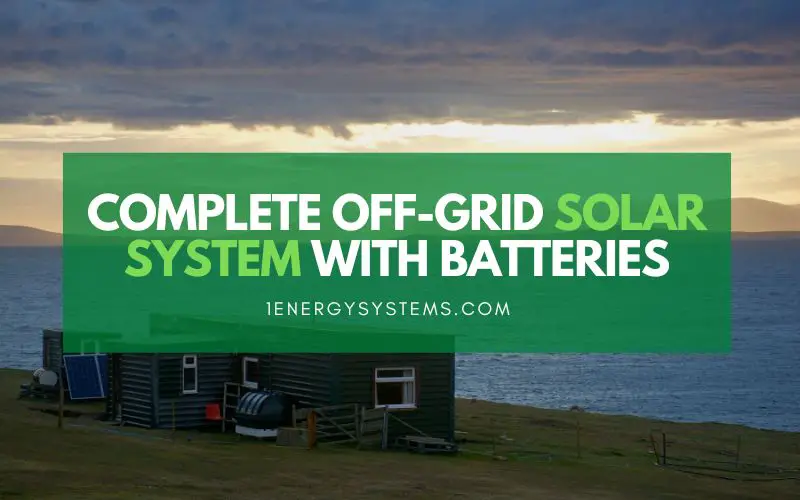Having a solar system as a backup for your grid connection is easier and less complicated than opting for complete off-grid solar systems. The keywords here would be capacity and reliability.
When you are connected to the grid, even if your solar system fails to generate electricity as expected due to less sunshine or system malfunctioning, the grid connection will take over and you will continue to enjoy uninterrupted electricity, even if you have to pay for it.
However, with complete off-grid solar systems, this is not a possibility. If your solar system fails to generate sufficient clean energy for your needs, you will suffer the consequences. Even after spending thousands of dollars on a solar system, if the system is not generating enough renewable energy, you will have insufficient or no electricity for use.
To avoid such a situation, you need to invest some time in understanding your requirements and various off-grid solar system considerations. When choosing complete off-grid solar systems, quality is of prime importance to avoid unexpected malfunctioning.
This article will help you choose the best complete off-grid solar system with batteries to suit your requirements. Besides the buying guide, you will also find some of the best off-grid solar systems available in the market listed here with brief reviews.
Buying guide: Complete off-grid solar system with batteries
When you want to switch to clean energy and opt for a complete solar system for off-grid installation, you need to consider the essential components for such a setup.
The main components of off-grid solar systems are:
- Solar panels
- Solar inverters or solar charge controllers
- Dual-function or hybrid solar inverters
- Batteries
- Diesel-powered generator (as a backup – optional)
The choice between solar inverters and solar charge controllers depends on the size of the system. While smaller solar systems are DC-coupled and have MPPT charge controllers, the larger systems can be AC-coupled or DC-coupled based on the type of solar inverters chosen. Modern solar inverters can handle both AC-coupled and DC-coupled connections, offering more flexibility to the user.
Main considerations for the size of the system
- Average consumption per day in kWh
- Maximum load in kW
- Peak sun hours in your location
- Options available for backup
You can figure out the daily average consumption from past utility bills. It’s ideal to include the entire past year in the calculation so that your peak consumption in winter and summer will reflect in it. Peak load can be calculated by adding up the wattage of all the devices you may switch on at the same time.
The information on peak sun hours for your location can be obtained here. Whether you are including a diesel-powered generator as a backup option in the solar system is entirely your choice.
As the battery and dual-function hybrid inverter are the key components of a complete off-grid solar system, we will discuss the options available in this further.
Types of off-grid batteries
Lead-acid batteries
Deep-cycle lead-acid batteries ruled the roost until lithium batteries entered the scene. They are still popular because of their affordability and reliability. However, they also come with a host of disadvantages.
Pros:
- Tried and tested technology
- Compatible with most photovoltaic systems and solar inverters
- Will continue to function even when the voltage or charge remaining is low
- Safe and risk-free
- Long lifespan if properly maintained
- Easy to recycle
Cons:
- Heavy
- Maximum efficiency level of 75-80%
- Low energy density
- Limited usable energy, maximum 40-50% depth of discharge
- Not flexible or modular
- Unable to sustain a partial charge for much time
- High temperatures can reduce the lifespan
Lithium-Ion batteries
This is the new kid on the block and the darling of the masses. Though a new entrant in the battery scene, lithium-ion has captured a lion’s share of the market with its high efficiency levels of 92-98%. Compact, lightweight, and scalable, lithium-ion batteries have overcome the limitations of lead-acid batteries.
Unlike lead-acid batteries, lithium-ion ones can be added to the existing setup later on. This flexibility is a blessing for users. Higher energy density helps in making the batteries more compact and lighter. Also, lithium-ion batteries can sustain a partial or very low charge for long periods. Charging time is also considerably less for lithium-ion batteries.
Pros:
- High-efficiency level of 92-98%
- High energy density
- Lightweight and compact
- Scalable and modular
- Can be charged and discharged to the maximum
- No damage if left partially discharged
- Safe and risk-free if guidelines are followed
- Extended lifespan
Cons:
- Can function only in a limited temperature range (40-120℉)
- May trip when surge load is constantly high
- Isn’t compatible with all systems
- Harder to recycle
Dual-function or hybrid solar inverters
Hybrid solar inverters are an integral part of off-grid solar systems, whether they are AC-coupled or DC-coupled. When choosing hybrid solar inverters, the main considerations are reliability, flexibility, continuous and surge power rating, remote monitoring, software for energy management, and AC source control.
A wide range of hybrid solar inverters or inverter/chargers is available in the market with varying power output ratings to suit your needs. The most vital point to consider while selecting a hybrid inverter is its continuous and surge power ratings. For complete off-grid solar systems, inverter/chargers are available in capacities of 2.4kW to 20kW. If your power requirement is higher, you can connect them in parallel or use a 3-phase configuration.
These solar inverters are well-equipped to handle almost double the continuous rating for short periods. If motors, pumps, and compressors are involved, these solar inverters are best suited to handle initial power spikes. Surge power rating is equally important for complete off-grid solar systems to ensure uninterrupted operation under diverse load conditions without shutting down or tripping unexpectedly.
MPPT charge controllers
For smaller off-grid solar systems, MPPT charge controllers can handle the workload. They come in between the solar panels and the battery. Their function is to ensure the correct charging of the battery and prevent overcharging. Most of them also come with output terminals that you can use to tap the DC supply.
You can also use a plug-in AC inverter in such systems to get an AC supply. Such solar inverters are available in a wide range of 150W to 3kW to suit your requirement.
Best off-grid solar systems with batteries
Eco-Worthy Complete Solar Panel Kit (200W)
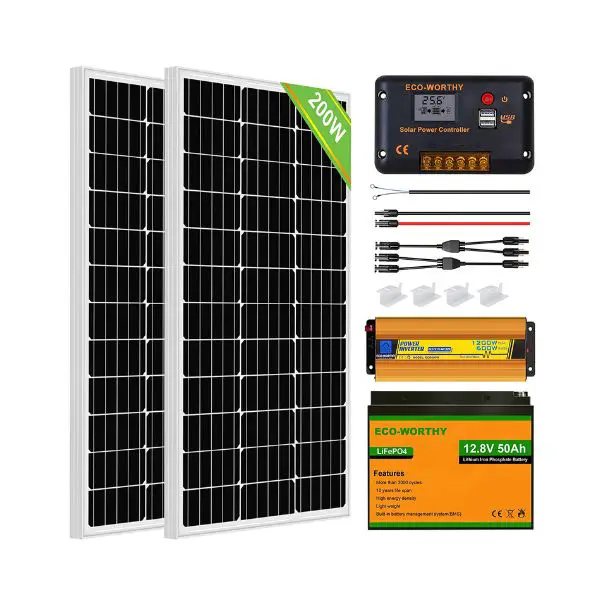
Power output: 200W
Includes:
- 2pcs 100W monocrystalline photovoltaic panel/s
- 30A charge controller
- 50Ah Lithium Battery
- 600W Solar Inverter
- 1 pair of Solar Cable & Y-Branch Connector
- 1 pair of Controller-to-Battery Cable
- 2 pcs 4-Z Brackets
Warranty: 1 year
This solar system kit comes with two 100W solar panels. It includes all that you may need to set up off-grid solar systems, including mounting equipment and connecting cables. If your energy requirement is limited, this is a good all-in-one solar starter kit for your home or RV.
WindyNation 400-Watt Solar Kit
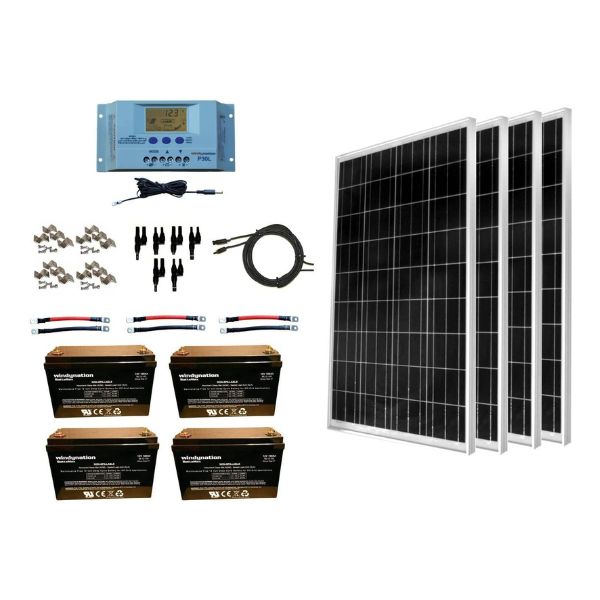
Power output: 400W
Includes:
- 4pcs 100W Polycrystalline Photovoltaic Panels
- 4pcs 100Ah AGM Deep Cycle Batteries
- 30 Amp P30L Solar Charge Controller
- 40 ft of UL-listed 12 AWG Solar Cable
- Solar Connectors for wiring
- Mounting hardware
Warranty:
- 5-year solar panel warranty
- 25-year power output warranty
- 1-year warranty on all other included components
With 4 solar panels, a charge controller, 4 deep-cycle AGM batteries, and all necessary accessories, this solar kit is a complete package for going solar. This kit is ideal for use in RVs, cabins, and boats and as a backup for homes.
Tiny House Solar Power System (Base Kit 1) (720W)
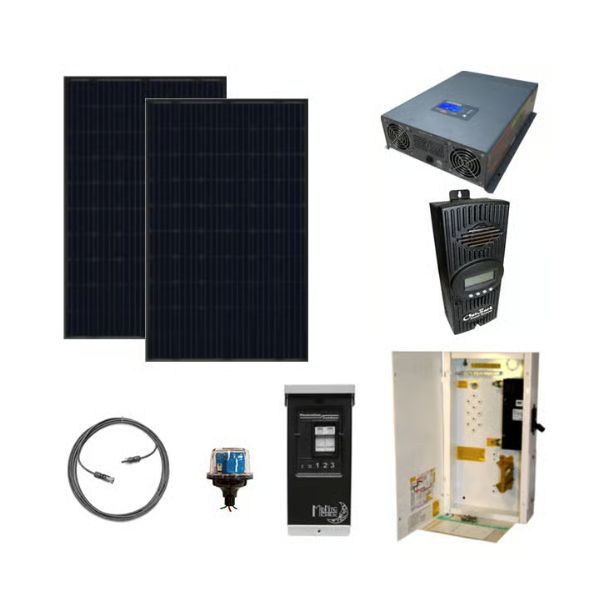
Power output: 720W
Includes:
- 2pcs 360W monocrystalline solar panels
- Xantrex Freedom XC 1000 Inverter/Charger (1000W, 12V)
- Outback Power FLEXmax 60 MPPT Charge Controller
- 180Ah AGM battery or 150Ah Lithium (LFP) battery
- All necessary cables and mounting accessories
Warranty:
- 5 years for AGM battery
- 7.5 years for lithium battery
- 10-year material warranty for solar panels
Offering 720 watts of power, this complete solar system can support the energy needs of a small home, or any other off-grid entity. Though battery storage and mounting equipment are not included in the package, the website gives the option of buying them together in one go.
The inverter has the capacity to provide 1kW of 120V AC power output. It can handle power surges up to 2kW, which means it can accommodate appliances like refrigerators. The inverter is capable of functioning in a temperature range of -4°F to 104°F.
Tiny House Solar Power System (Base Kit 2) (1.44kW)
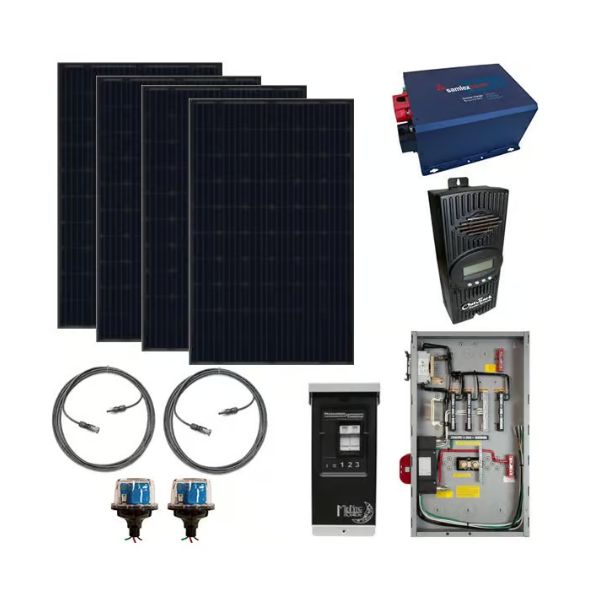
Power output: 1.44kW
Included:
- 4pcs 360W monocrystalline solar panels
- Samlex EVO-2224 Pure Sine Wave Inverter/Charger (2200 Watts, 24V) with remote control
- Outback Power FLEXmax 60 MPPT Charge Controller
- 180Ah AGM battery or 150Ah Lithium (LFP) battery
- All necessary cables and mounting accessories
Warranty:
- 5 years for AGM battery
- 7.5 years for lithium battery
- 10-year material warranty for solar panels
With this all-in-one solar system in place, you need not worry about your energy needs even when you are not connected to the grid. If you are living in a sunny location, with the 4 360W high-efficiency monocrystalline solar panels and a compatible battery, you will enjoy free solar energy day and night.
The inverter/charger is capable of providing a constant 2.2kW of 120V AC output. The battery charger in the kit allows adaptive three or four-stage charging with provision for equalizing the charge. The AC inputs present facilitate the addition of a generator in the system.
Tiny House Solar Power System (Base Kit 3) (2.16kW)
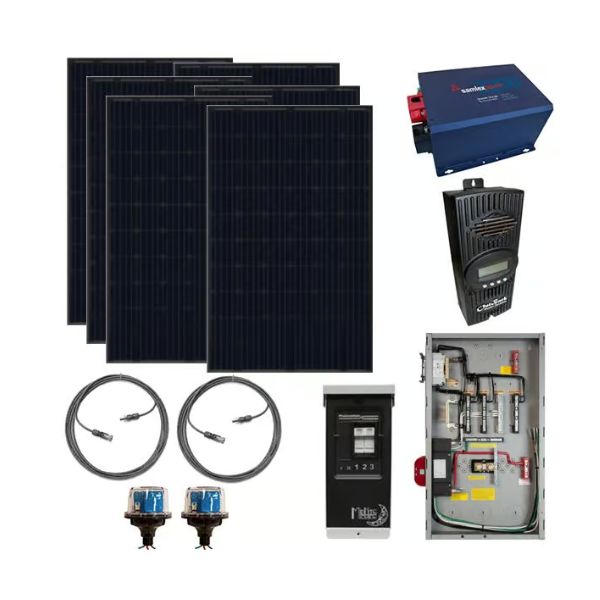
Power output: 2.16kW
Included:
- 6pcs 360W monocrystalline solar panels
- Samlex EVO-4024 Pure Sine Wave Inverter/Charger (4000 Watts, 24V) with remote control
- Outback Power FLEXmax 80 MPPT Charge Controller
- 180Ah AGM battery or 150Ah Lithium (LFP) battery
- All necessary cables and mounting accessories
Warranty:
- 5 years for AGM battery
- 7.5 years for lithium battery
- 10-year material warranty for solar panels
Whether you want to save up on utility bills or are concerned about the environmental damage caused by the burning of fossil fuels, this 2.16kW solar system can fulfill your wishes without disrupting your lifestyle. Even though the battery storage and mounting equipment are add-ons, you can order them together with the solar kit.
The inverter/charger has the capacity to deliver 4kW of constant 120V AC supply. You can also add a generator to the system taking advantage of the 2 AC inputs.
Bottom line
The whole idea behind a complete off-grid solar system with batteries is to eliminate your dependence on grid energy and switch to renewable energy. If you are living in a remote location, this is not a choice but a necessity. Whether you opt for off-grid solar systems by choice or compulsion, the pros and cons remain the same. With this system, you can avoid utility bills altogether, but the initial investment is quite high. You may need 8-10 years to recover the investment.
On the plus side, you achieve energy independence by switching over to solar energy. But you have to rely on batteries to ensure a power supply at night. You will no longer be affected by power outages. But since you are not connected to the grid, you cannot take advantage of the net metering arrangement.
With off-grid solar systems, you are assured of a constant power supply even if you live far away from the grid. But before you go ahead with this, you need to ensure that this is legal in your location. It’s not allowed all over the country.

